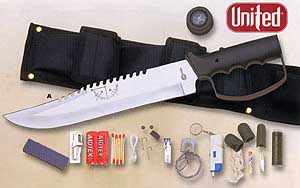Featured Member Video
Survival TarpMore Videos by IA Woodsman
View larger or ask the author a question.
View all wilderness survival videos
Recent Forum Posts 
Come Join the Discussion Today!
Our site has been mentioned in:
U.S. News and World Report
Best of the Web - Site of the Week 8/6/01
Discovery Channel Canada
One Week in the Wilderness
USA Today
Hot Sites 08/08/2005
Medications and Treatments
The previous section was all the things you can do to avoid catching one of these diseases, but now you have to figure out what to do when someone is infected. Just remember this is general information and shouldn't be considered certified medical advice.
Over the Counter ProductsThough it's a little silly to say you can treat these serious diseases with common drug store products, don't overlook them. Many diseases don't have a cure and the only thing you can do is survive the symptoms until your body fights it off on your own. Over the counter (OTC) drugs can help. We mentioned this a bit earlier as part of your standard prepper supplies but again you'll want:
Ibuprofen or acetaminophen for fever and body aches
Anti-nausea and anti-diarrhea medications
Electrolyte fluid replacement, or ability to make a homemade version
Medications like ibuprofen (Advil), acetaminophen (Tylenol) and aspirin are extremely handy to have around for headaches, joint pains and to bring down fever. High fever is a major symptom in so many diseases and it is dangerous all on its own, so you want to have meds around to keep that under control while the disease runs its course.
Several diseases present with severe diarrhea, which will lead to death from dehydration all on its own. Standard anti-diarrhea medications like Imodium or even Pepto-Bismol can help, as long as the diarrhea isn't too severe. With something like cholera, you'll want to focus on fluid replacement instead.
The point isn't to just replace water though, but also electrolytes (like sodium) as well. Sports drinks are a reasonable option, and you can get similar products at the drug store that aren't quite so sugar-laden. Pedialyte is a good one for kids. If you are on your own, make a solution of 1 quart boiled water, mixed with 1/2 teaspoon of table salt and 6 teaspoons of white sugar. It's hard to say how much of this mixture to give, but expect that someone with diarrhea would need 2 or 3 quarts per day.
AntibioticsEveryone thinks about stockpiling antibiotics when they think about pandemic preparedness, mainly because people have a skewed viewpoint on just how important these medications are. Viral diseases are not effected by antibiotics at all. You also can't buy them freely (you need prescriptions) and they generally have short shelf-lives.
There are many dozens of antibiotics out there, and without some medical training, you're not going to know how to use or dispense them all anyway. We can't include that much information here.
Once you've read through the various disease profiles later in this book, you'll notice that ciprofloxacin is the most commonly effective choice, so if you do want to have antibiotics on hand, this is the one to choose. It's a good treatment for almost every bacterial disease we've talked about and it limits the complications of trying to manage a host of potential drugs.
It usually comes in 250mg and 500mg tablets. Intravenous solutions aren't going to be too practical for the average person. The dosing will vary by disease, though the general dose is 500mg twice a day for a few weeks. More specifically:
Anthrax - 500mg every 12 hours for 60 days
Cholera - a single dose of 1g (i.e. 2x500mg tablets)
Bubonic plague - 500mg every 12 hours for 10 days
Tuberculosis - 750mg every 12 hours for 18 months (other drugs are better suited)
Tularemia - 500 mg every12 hours for 14 days
Typhoid fever - 500 mg every 12 hours for 10 days
These are the dosages for adults. For children, adjust the amounts to 15 mg per kilogram of weight.
There are some potential side effects for cipro, notably joint pain and swelling of the tendons. It can also cause slight diarrhea and nausea in some people. Compared to dealing with cholera or plague, these are minor problems.
As most preppers know, you can get around the need for prescriptions by getting veterinary medications. We're not necessarily recommending this approach, just giving out the information for you to make your own choices. Fish Flox Forte, for example, is ciprofoxacin in 500mg tablets. It's intended for aquarium use but it's chemically the same as the cipro you would get for humans.
Store your cipro (or any other antibiotics for that matter), in a cool, dry place out of direct sunlight.
While we're talking about antibiotics, you should be very aware that people can have serious reactions to some of these drugs. Penicillin in notorious for allergic reactions, and about 10% of the population is allergic. If this applies to you or someone in your family, be aware that a penicillin allergy would apply to other related antibiotics like amoxicillin, ampicillin and docloxacillin.
Ultimate Survival Knife & Kit |
List Price: 61.99 Our Price: 39.95 |
This 15 inch survival knife with drop point blade features a thick quality stainless steel blade with serrated top edge. Textured and ribbed solid metal handle and guard. Nylon sheath. Survival kit includes a hollow grip with a compass top to store items within the knife itself, as well as additional pouches on the sheath to hold the rest. Complete survival kit. Click Here to Buy the Survival Knife Now. |
|

